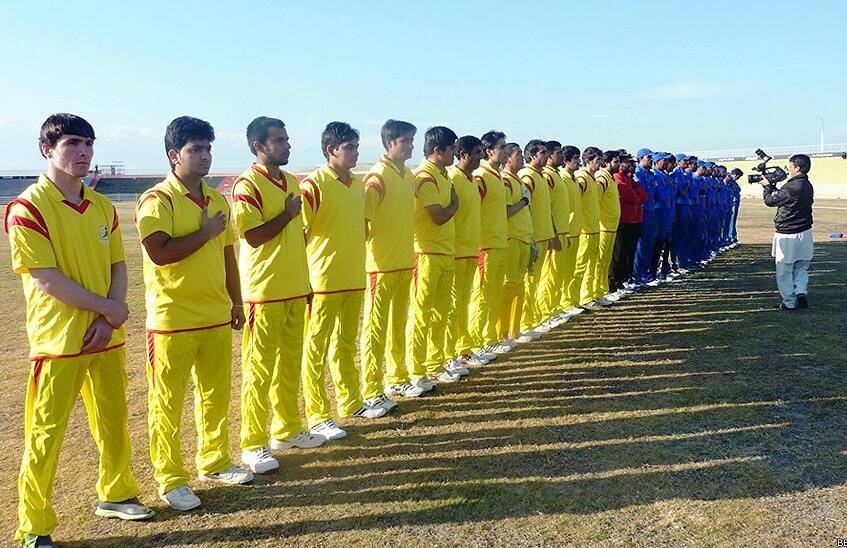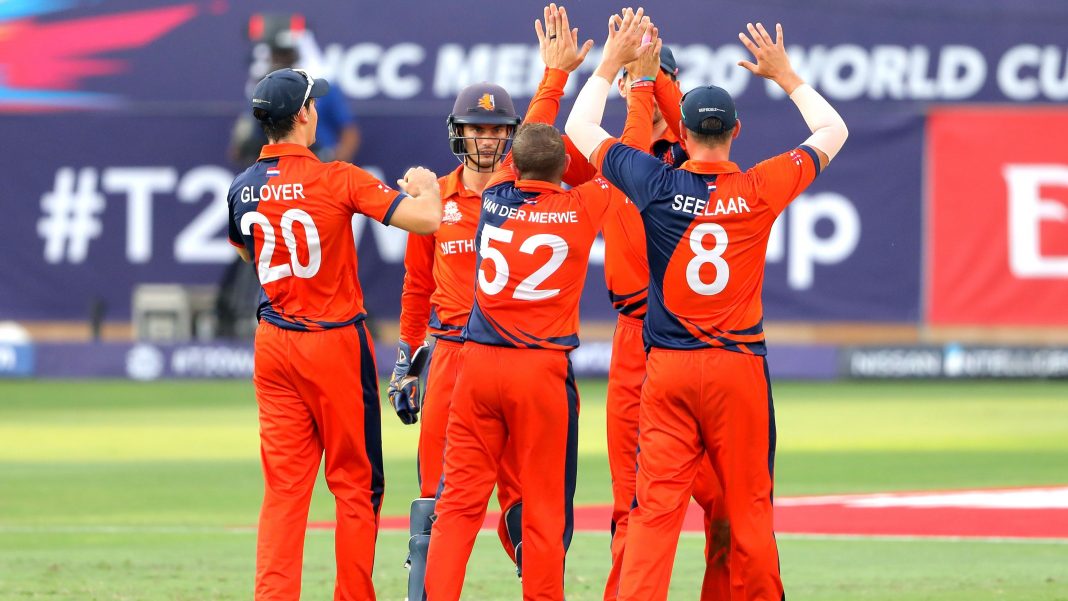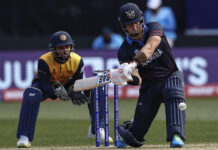As cricket seeks to extend its reach to wider communities, to expand in countries where English is not the first language, the issue of communication inevitably arises. For historical reasons, English is cricket’s lingua franca, but is it the best medium for selling the game in Paraguay, or Chad, or Kyrgyzstan?
This is, as it happens, not a new question. A version of it was asked by a correspondent in the Amsterdamsche Courant in 1875, at a time when the Amsterdam Cricket Club, first established in 1871, was advertising for new members.
The writer welcomed the idea that the Dutch might adopt cricket, given the absence of native outdoor sports which ‘could be played in the open air, and which at the same time exercise and strengthen the body and relax the mind’.
Yet at the same time, the alien unfamiliarity of the name and terminology was an obstacle, and needed to be confronted. He wished the game to be called balspel [ball game], and the English terms which stood in the way of the sport’s development should be translated:
“There is not a single reason why a ‘bowler’ should not be called a ‘roller’, and why he should not call ‘speel!’ instead of ‘play!’ or ‘game!’ etc.
I advise the Amsterdam Cricket Club to adopt this change of name and to Dutchify this very attractive game. Let the club not say that they play for themselves, and not for others. It is just because I wish them to be less egoistic and want their game to become more generally known that I offer my comment . . . “
This linguistic preoccupation apart, the writer declared himself a great enthusiast for the game: if the club’s members would create cricket grounds in public spaces and offer themselves as instructors, he suggested, cricket would quickly be taken up, with the great social benefit of getting people out of the houses and pubs and involved in a healthy and enjoyable activity.
The original ACC did not last long – the current club of that name wasn’t established until 1921 – but by the end of the 1870s clubs were beginning to spring up elsewhere and football, and to a lesser extent cricket, were proving popular with an Anglophile sector of Dutch society.
Ian Buruma has written acutely about the way in which the Victorian preoccupation with sport as a positive social influence, stemming from Dr Arnold and Rugby School, appealed to the middle class across the Continent, and the Netherlands was no exception: football was eventually able to escape its Anglophile, upper-class origins, but cricket would always retain its (largely deserved) reputation as an elitist sport.

But by 1883 the game was sufficiently well-established for a national body, the Nederlandsche Cricket Bond [NCB], to be set up, and it was soon organising inter-club tournaments which would evolve, in 1891, into a national league.
For some, though, the linguistic factor remained an issue. In March 1884 there was a lively exchange of views in De Nederlandsche Sport, now the leading sporting weekly in the country, about the development of a distinctively Dutch cricket terminology.
A correspondent signing himself ‘JS’ wrote that he had been shown a glossary of ‘Dutch’ cricketing terms intended to make the promotion of the game easier: the wicket, for example, could be called the poortje [little gate], the striker the kolver and the bowler the baller, while a no ball could be a misbal and a wide a rekbal.
Furthermore, JS argued, Dutch-language scorebooks were needed if cricket were truly to reach a wider public.
The following week another enthusiast signing himself ‘WV’ countered with a list of no fewer than 29 translations; in some cases he agreed with JS, but in others he offered alternatives, such as gooier [thrower] for bowler and verre bal [‘far ball’] for a wide.
But WV admitted that he had been unable to find Dutch equivalents for the various fielding positions, nor could he provide a suggestion for ‘maiden over’; if he understood the underlying reference in this latter case, nineteenth-century decorum, in an age when for the sake of decency the legs of pianos had to be provided with skirts, might have prevented him from explaining it.
JS returned to the discussion in the next issue, challenging several of WV’s suggestions and objecting in particular to that of gooier, on the basis that throwing was specifically barred by the Laws of Cricket.
He also republished the translation of the Laws which the old ACC had issued in 1875, noting with some justification that many of the cricket-specific terms had been poorly chosen in that version. There, the debate appears to have died.
It is interesting to speculate what might have happened had the infant NCB made a conscious decision to create a Dutch cricket terminology.
But, unlike Denmark, the Netherlands never adopted an adapted scorebook, and match reports in the sporting press continued for the most part to use English terms.
And it is no coincidence that cricket remained almost exclusively the preserve of the upper and upper-middle classes, with scorecards firmly giving the social and academic titles of the players.
That, indeed, remained the prevailing situation into at least the 1980s: one Australian coach from that period tells of his outreach efforts into local schools being greeted by a KNCB official with the remark that ‘we don’t want people like that playing cricket!’
That attitude may well have contributed to the steady decline of cricket among the local Dutch population since the mid-eighties, which has been masked to a degree by the increase in the percentage of male players of Asian background to around 60% of the total.
The problems faced by those seeking to promote the game in the Netherlands are mirrored by those which apply in other countries where cricket does not have a heritage of a century and a half, and language must be recognised as one of the limiting factors in its growth.
It is perhaps time for that debate from the 1880s to be taken up again, and for the ICC to tackle the language issue which the NCB failed to engage with back when cricket was battling to gain a toehold in Dutch society.
You’re reading Emerging Cricket — brought to you by a passionate group of volunteers with a vision for cricket to be a truly global sport, and a mission to inspire passion to grow the game.
Be sure to check out our homepage for all the latest news, please subscribe for regular updates, and follow EC on Twitter, Facebook, LinkedIn and YouTube.
Don’t know where to start? Check out our features list, country profiles, and subscribe to our podcast.
Support us from US$2 a month — and get exclusive benefits, by becoming an EC Patron.








Interesting article, especially from a historic perspective. I would argue though that language is probably the least contributing factor in the decline of interest in the game. In all my years promoting junior cricket I have encountered less than a handful of parents that found this bi-linguality confusing for their kids and left. Most parents would love it and embrace English as the binding factor between all the cultures that run around.
Our society is changing. Look at our universities, the business places and as a consequence our clubs, our volunteers, our coaches, etc. They stem from a rich variety of countries and cultures and sports in general and cricket in particular offers a unique platform to be the melting pot with the game as a shared passion. And for that it needs a common language, so words like poortje, gangetje, loopies, wachter etc. are not very helpful.
For that reason my club’s website is bilingual and the GMM and the newsletter are in English (with a Translate button translating the latter in seconds into 30+ other languages). Because if you want your members to be involved you better communicate with them. Would you go to a meeting in China if all they speak is Mandarin (and complain about your lack of interest)?
The times when we lived and died our lives in only one place are long gone by and for clubs, it is important to adjust to the fact that memberships of 50+ years will become rarer. We need to accommodate, connect, and educate, and for that we need a common language. And English seems to be the most natural connector to be able to grow the game.